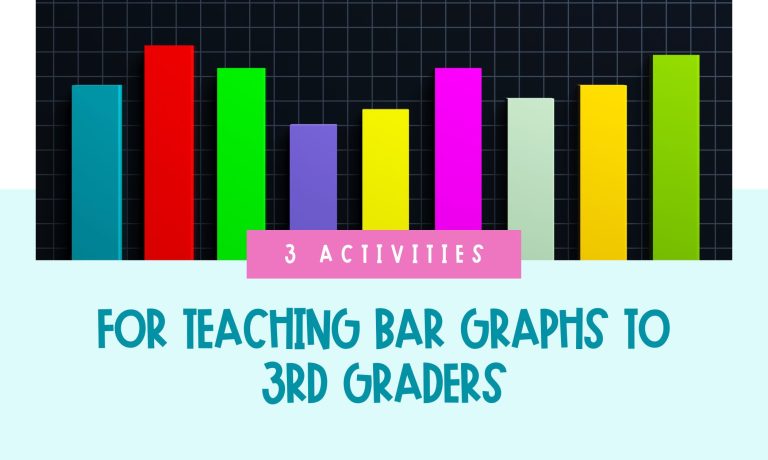Teaching bar graphs to 3rd graders is essential to their math education. However, engaging young learners in this topic can sometimes be challenging. That’s why incorporating interactive activities into lesson plans can make a significant difference. In this blog post, we will explore the importance of teaching bar graphs to 3rd graders, the benefits of interactive learning, and provide a range of interactive activities to spark interest and enhance comprehension.
Teaching Bar Graphs Basics
Definition of a Bar Graph:
Begin by introducing 3rd graders to the concept of a bar graph. Explain that a bar graph is a visual representation of data using rectangular bars of different lengths. Each bar represents a category, and the length of the bar corresponds to the quantity or value of the data it represents. Bar graphs are excellent tools for comparing data, identifying patterns, and making data-driven decisions.
Parts of a Bar Graph:
To ensure a comprehensive understanding, introduce the key components of a bar graph:
- Axes: The vertical axis, also known as the y-axis, represents the data values, while the horizontal axis, the x-axis, displays the categories being compared.
- Bars: The rectangular bars are drawn vertically or horizontally, starting from the axis. The length of each bar represents the data value for the corresponding category.
- Labels: Clear and descriptive labels should be used for both axes and each bar to identify the categories and their respective values.
- Title: The title conveys the overall theme or purpose of the bar graph, helping readers understand the context of the data.
How Bar Graphs Represent and Compare Data:
Illustrate the concept of data representation using bar graphs with relatable examples. For instance, you can show a bar graph displaying the number of fruits each student brought to school for a healthy snack. Demonstrate how the length of each bar reflects the quantity of fruit, and how the bars can be easily compared to identify which fruit is the most and least popular.
The Power of Interactive Learning:
Interactive activities play a vital role in capturing the attention and interest of 3rd graders. Hands-on experiences enable students to actively participate in learning, improving comprehension and retention. Educators can foster engagement, motivation, and a deeper understanding of the topic by incorporating interactive elements.
Interactive Bar Graph Ideas for 3rd Grade:
Activity 1: Graphing Favorite Foods
Students will create a bar graph showcasing their favorite foods in this fun and delicious activity. Start by brainstorming a list of popular foods together as a class. Then, have students work in small groups or individually to conduct a survey asking their classmates to vote for their top three favorite foods. Students will collect and organize the data using chart paper, markers, and sticky notes.
Next, guide the students on creating a bar graph with the collected data. Encourage them to label the axes clearly and use different colors for each food item. After completing the graph, students can present their findings to the class, highlighting the most and least popular foods. This activity enhances graphing skills and promotes social interaction and teamwork.
Activity 2: Creating Classroom Surveys
This activity empowers students to be survey designers and data collectors. Divide the class into pairs or small groups and have each group come up with a unique survey question. The questions can be related to favorite hobbies, pets, ice cream flavors, or anything that interests 3rd graders.
Provide survey templates, pencils, and clipboards to the students. They will then roam around the classroom, interviewing their peers and recording their responses. Once the data is collected, guide the students in organizing the information and creating a bar graph based on the survey results. This activity reinforces graphing skills and promotes critical thinking and communication.
Activity 3: Interactive Online Games
Embrace technology in the classroom by incorporating interactive online games. Several websites and apps offer engaging graphing activities suitable for 3rd graders. For example, “Data Puzzles” allows students to sort and interpret data sets, while “Bar Graphing with Roly” challenges them to answer questions based on the presented bar graphs.
Reserve a computer lab session or use tablets in the classroom to let students explore these games independently or in pairs. The excitement of interactive learning will motivate them to improve their graphing skills and reinforce their understanding of bar graphs.
Teaching Bar Graphs with Real-Life Applications:
Teachers can connect the concept to real-life situations to make bar graph learning more meaningful. Field trips, such as visiting a farmer’s market or a local store, allow students to collect data and create bar graphs based on their observations. Encouraging students to interpret and analyze real-world graphs enhances their understanding of the relevance and applications of bar graphs in everyday life.
Resources and Tools for Teaching Bar Graphs:
Educators can utilize various resources and tools to further support the teaching of bar graphs. Recommended books, interactive websites, and apps can provide additional practice and reinforce the concepts learned in class. These supplementary materials can enhance student engagement and provide independent learning and exploration opportunities. Click here to grab some fun activities for your students.
Teaching bar graphs to 3rd graders become more enjoyable and effective when incorporating interactive activities. You can spark interest and foster a deeper understanding of bar graph concepts by engaging students through hands-on experiences, online games, and real-life applications. By embracing interactive learning, we can inspire curiosity and lay the foundation for a lifetime of mathematical understanding. Let’s ignite the passion for bar graphs in our 3rd graders and watch them excel in data representation and analysis.
